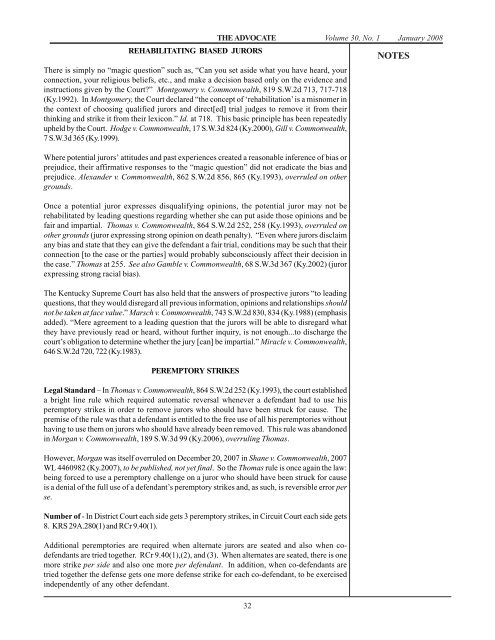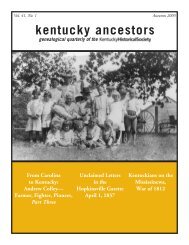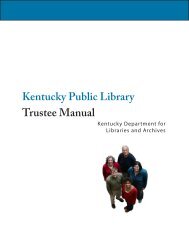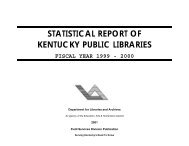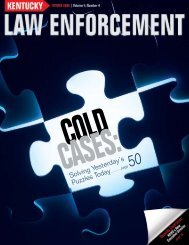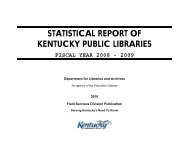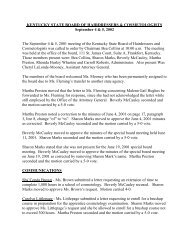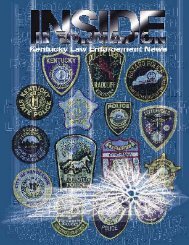Jan08 Advo.pmd - e-archives Home
Jan08 Advo.pmd - e-archives Home
Jan08 Advo.pmd - e-archives Home
You also want an ePaper? Increase the reach of your titles
YUMPU automatically turns print PDFs into web optimized ePapers that Google loves.
REHABILITATING BIASED JURORS<br />
THE ADVOCATE Volume 30, No. 1 January 2008<br />
There is simply no “magic question” such as, “Can you set aside what you have heard, your<br />
connection, your religious beliefs, etc., and make a decision based only on the evidence and<br />
instructions given by the Court?” Montgomery v. Commonwealth, 819 S.W.2d 713, 717-718<br />
(Ky.1992). In Montgomery, the Court declared “the concept of ‘rehabilitation’ is a misnomer in<br />
the context of choosing qualified jurors and direct[ed] trial judges to remove it from their<br />
thinking and strike it from their lexicon.” Id. at 718. This basic principle has been repeatedly<br />
upheld by the Court. Hodge v. Commonwealth, 17 S.W.3d 824 (Ky.2000), Gill v. Commonwealth,<br />
7 S.W.3d 365 (Ky.1999).<br />
Where potential jurors’ attitudes and past experiences created a reasonable inference of bias or<br />
prejudice, their affirmative responses to the “magic question” did not eradicate the bias and<br />
prejudice. Alexander v. Commonwealth, 862 S.W.2d 856, 865 (Ky.1993), overruled on other<br />
grounds.<br />
Once a potential juror expresses disqualifying opinions, the potential juror may not be<br />
rehabilitated by leading questions regarding whether she can put aside those opinions and be<br />
fair and impartial. Thomas v. Commonwealth, 864 S.W.2d 252, 258 (Ky.1993), overruled on<br />
other grounds (juror expressing strong opinion on death penalty). “Even where jurors disclaim<br />
any bias and state that they can give the defendant a fair trial, conditions may be such that their<br />
connection [to the case or the parties] would probably subconsciously affect their decision in<br />
the case.” Thomas at 255. See also Gamble v. Commonwealth, 68 S.W.3d 367 (Ky.2002) (juror<br />
expressing strong racial bias).<br />
The Kentucky Supreme Court has also held that the answers of prospective jurors “to leading<br />
questions, that they would disregard all previous information, opinions and relationships should<br />
not be taken at face value.” Marsch v. Commonwealth, 743 S.W.2d 830, 834 (Ky.1988) (emphasis<br />
added). “Mere agreement to a leading question that the jurors will be able to disregard what<br />
they have previously read or heard, without further inquiry, is not enough...to discharge the<br />
court’s obligation to determine whether the jury [can] be impartial.” Miracle v. Commonwealth,<br />
646 S.W.2d 720, 722 (Ky.1983).<br />
PEREMPTORY STRIKES<br />
Legal Standard – In Thomas v. Commonwealth, 864 S.W.2d 252 (Ky.1993), the court established<br />
a bright line rule which required automatic reversal whenever a defendant had to use his<br />
peremptory strikes in order to remove jurors who should have been struck for cause. The<br />
premise of the rule was that a defendant is entitled to the free use of all his peremptories without<br />
having to use them on jurors who should have already been removed. This rule was abandoned<br />
in Morgan v. Commonwealth, 189 S.W.3d 99 (Ky.2006), overruling Thomas.<br />
However, Morgan was itself overruled on December 20, 2007 in Shane v. Commonwealth, 2007<br />
WL 4460982 (Ky.2007), to be published, not yet final. So the Thomas rule is once again the law:<br />
being forced to use a peremptory challenge on a juror who should have been struck for cause<br />
is a denial of the full use of a defendant’s peremptory strikes and, as such, is reversible error per<br />
se.<br />
Number of - In District Court each side gets 3 peremptory strikes, in Circuit Court each side gets<br />
8. KRS 29A.280(1) and RCr 9.40(1).<br />
Additional peremptories are required when alternate jurors are seated and also when codefendants<br />
are tried together. RCr 9.40(1),(2), and (3). When alternates are seated, there is one<br />
more strike per side and also one more per defendant. In addition, when co-defendants are<br />
tried together the defense gets one more defense strike for each co-defendant, to be exercised<br />
independently of any other defendant.<br />
32<br />
NOTES


